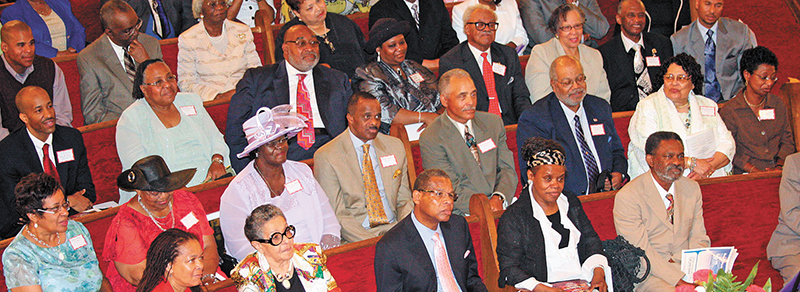Civil
Monument Honoring Norfolk 17’s Contributions To Be Dedicated

By Leonard E. Colvin
Chief Reporter
New Journal & Guide
After 14 years, hours of research and a few technical barriers, the monument honoring the Norfolk 17’s role in desegregating Norfolk’s Public Schools six decades ago will be dedicated.
Mayor Kenneth C. Alexander, artists, dignitaries, and members of The Norfolk 17 and The Lost Class of 1959 will be on hand at the unveiling of the “End of Massive Resistance” public artwork at 114 W. Charlotte St. on Thursday, April 27 at 10 a.m.
The “End of Massive Resistance,” art work is an 8-foot-by-57-foot wall created by Shane Albritton and Norman Lee of RE:site.
The sculpture is composed of brick and glass in a graded transformation that explores the concept of breaking down the barrier of segregated public education.
A historic photographic timeline of events and text includes “Seventeen Ways,” by local poet Tim Seibles.
Sunlight penetrating the glass will symbolize the triumph of social justice and opaque bricks gesture toward the ongoing work of creating equitable public schools in the city.
In September 1958, six all-white middle and high schools in Norfolk were ordered by Virginia Governor Thomas B. Stanley to close rather than integrate as part of a policy called “Massive Resistance” declared by U.S. Senator Harry F. Byrd Sr. of Virginia and adopted in 1956 by Virginia’s state government.
Massive Resistance was Stanley’s and other southern governors’ strategy to apply legal and legislative powers to ‘resist’ complying with the 1954 U.S. Supreme Court’s ruling declaring racially segregated public schools illegal.
The high court agreed with an NAACP suit, Brown Vs. The Topeka Kansas Public Schools.
The Brown suit was combined with several others, including Prince Edward County, Virginia, where efforts by Blacks seeking to desegregate public schools’ were rebuffed.
As part of its Massive Resistance policy, Virginia began to provide grants to white parents for children to attend all-white private schools which were enrolling children fleeing public schools targeted for desegregation.
At one point Virginia, rather than comply with the Brown Decision, proposed abolishing its system of public schools.
After the federal Judge Walter Hoffman, in Norfolk, ordered the city to enroll the Norfolk 17 into six all-white schools, the targeted schools were closed in the fall of 1958.
But the NAACP maintained the legal pressure and Black civic and political leaders followed suit.
To assure the skills of the students would remain on par, the Norfolk 17 were provided a prep school at First Baptist Bute Street that fall organized by Black educators and civic leaders.
At one point Norfolk Mayor W. Fred Duckworth, a Stanley ally, said during a city council meeting that the crisis over the closure of the schools would be ended if the Black community halted the effort to desegregate them.
But white business leaders, fearing economic ruin, pulled the rug from under the mayor. They issued a proclamation, calling for the end of the school closures. Even so, their announcement did not respect the intent of the Brown Decision.
In January 1959, the federal court overturned the state’s closure of the six schools.
On Feb. 2, 1959, despite the tension in the city, the Norfolk 17 joined thousands of white students, officially desegregating Norfolk’s schools.
The Norfolk 17 suffered many hardships for the cause while many white students also locked out of the schools never got to complete their education and became known as the “Lost Class of 1959.”
Karen Rudd, the Manager of Norfolk Arts, which oversees the development of public artworks in the city, said the Massive Resistance project was launched during the 50th anniversary of the role of the living members of the Norfolk 17 during a series of events in 2009.
Rudd said that city leaders reviewed a variety of concepts for the monument and venues for it.
The location at Charlotte and Granby Street was a strategic historic and civic move.
“Downtown is in the heart of the city where you have business and activity, and lots of the city’s history for people to view easily,” said Rudd.
Standing in front of the monument, and looking northward, one can see the U.S. Federal Courthouse, named for Judge Hoffman.
In that gray old building, the legal battles leading up to the decision to open the six schools were fought.
The artist team of Texas-based “RE: site art Studio” specializes in creating public art, memorials, and commemorative spaces that connect the past with the present by inspiring shared experiential moments, collaborative viewership, curiosity, discovery, and dialogue.
She said the artists are passionate about helping communities honor difficult histories and recovering the voices of those who struggled for justice, freedom, and human dignity.
The artistic image of the shattering of walls and bricks absorb the iconic image of the Norfolk 17 huddled in front of the First Baptist Bute Street on a chilly Fall Day in 1958 after they attended the prep school in the church’s basement.
Rudd and historians involved in the project in the timeline leading up to February 2, 1959, admit that day did not mark the “end” of the Massive Resistance” resistance to integration or racial segregation. Nor is the artwork a “memorial” since eight of the Norfolk 17 are still alive.
Instead, it is a “Commemoration” of the Norfolk 17’s role in one of the victories in the slow, ongoing destruction of the walls of “resistance” to equality, one or two bricks at a time.
You may like
-


PART TWO: 40 Acres and a Lie
-


Panel At HU Discusses 70th Anniversary of Historic School Desegregation Ruling
-


Iconic Daisy Bates Statue Unveiled In U.S. Capitol’s Statuary Hall
-


HRBRAA Gears Up For Its Second Radio Legends Wall of Fame Induction
-


Longwood To Honor Prince Edward Civil Rights Heroes
-


Norfolk’s New Fire Chief















